Old Processes, New Movements: The Inclusion of Geodiversity in Biological and Ecological Discourse
Abstract
:1. Introduction
- The range of geodiversity definitions and concepts used in academic literature;
- The fields of research in which geodiversity is being considered as an area of research and application; and,
- The perceived value of geodiversity as a component of research and practice in domains such as nature conservation, restoration ecology, geosciences, and heritage studies.
2. Materials and Methods
2.1. Classification of Data
2.2. Data Analysis
3. Results
3.1. Variations on the Definition of Geodiversity in Published Works
3.2. Geodiversity, Biodiversity, and Ecosystem Services
4. Discussion
4.1. Geodiversity is a Term Used in Geoheritage, Geoscientific, and Geotourism Research, Where (Most) People Use A Specific Definition …
4.2. …(But) Not Everyone Applies the Same Elements of Geodiversity
4.3. Qualitative Elements of Geodiversity and Biodiversity Ensure Mutual Enjoyment of Non-Equivalent Values
4.4. Are Quantitative Applications and Interpretations of Geodiversity the Way to Foster Cross-Disciplinary Research and Linkages with Biodiversity?
4.5. Notwithstanding Logistical Constraints, Why Hasn’t There Been Much Crossover between Geodiversity and Biodiversity Research and Discourse in Academic Literature?
5. Conclusions
Author Contributions
Funding
Acknowledgments
Conflicts of Interest
References
- Gray, M.; Gordon, J.E.; Brown, E.J. Geodiversity and the ecosystem approach: The contribution of geoscience in delivering integrated environmental management. Proc. Geol. Assoc. 2013, 124, 659–673. [Google Scholar] [CrossRef]
- Stepišnik, U.; Trenchovska, A. A New Quantitative Model for Comprehensive Geodiversity Evaluation: The Škocjan Caves Regional Park, Slovenia. Geoheritage 2018, 10, 39–48. [Google Scholar] [CrossRef]
- Ibáñez, J.-J.; Brevik, E.C.; Cerdà, A. Geodiversity and geoheritage: Detecting scientific and geographic biases and gaps through a bibliometric study. Sci. Total Environ. 2019, 659, 1032–1044. [Google Scholar] [CrossRef]
- Ruban, D.A. How diverse should be geodiversity? Reply to Knight “Evaluating geological heritage”. Proc. Geol. Assoc. 2011, 122, 511–513. [Google Scholar] [CrossRef]
- Brilha, J.; Gray, M.; Pereira, D.I.; Pereira, P. Geodiversity: An integrative review as a contribution to the sustainable management of the whole of nature. Environ. Sci. Policy 2018, 86, 19–28. [Google Scholar] [CrossRef]
- Coratza, P.; Reynard, E.; Zwoliński, Z. Geodiversity and Geoheritage: Crossing Disciplines and Approaches. Geoheritage 2018, 10, 525–526. [Google Scholar] [CrossRef]
- Brilha, J. Inventory and Quantitative Assessment of Geosites and Geodiversity Sites: A Review. Geoheritage 2016, 8, 119–134. [Google Scholar] [CrossRef]
- Dixon, G. Geoconservation: An international Review and Strategy for Tasmania. Tasman. Parks Wildl. Serv. 1996, 35, 1–55. [Google Scholar]
- Eberhard, R.; Commission, A.H.; Australia, A.E. Pattern & Process: Towards a Regional Approach for National Estate Assessment of Geodiversity: Report of a Workshop Held at the Australian Heritage Commission on 26 July 1996; Canberra, A.C.T., Ed.; Environment Australia: Canberra, Australia, 1997; ISBN 978-0-642-27014-6. [Google Scholar]
- Sharples, C. Concepts and Principles of Geoconservation 2002.; Tasmania Parks and Wildlife Service: Hobart, Australia, 2002. [Google Scholar]
- Kiernan, K. The Conservation of Landforms of Coastal Origin: Conserving Tasmania’s Geodiversity and Geoheritage; Forest Practices Board: Hobart, Australia, 1997; p. 273. [Google Scholar]
- Duff, K. Natural Areas: A Holistic Approach to Conservation Based on Geology. In Proceedings of the Geological and Landscape Evolution; Geological Society of London: Malvern Hills, UK, 1993; pp. 121–126. [Google Scholar]
- Brocx, M.; Semeniuk, V. Geoheritage and geoconservation—History, definition, scope and scale. J. R. Soc. West. Aust. 2007, 90, 53–87. [Google Scholar]
- Gray, M. Geodiversity: Valuing and Conserving Abiotic Nature 2004; John Wiley & Sons: London, UK, 2004. [Google Scholar]
- Zwoliński, Z.; Najwer, A.; Giardino, M. Methods for assessing geodiversity. In Geoheritage: Assessment, Protection, and Management; Elsevier: Cambridge, MA, USA, 2017; pp. 27–52. [Google Scholar]
- Protected Area Categories. Available online: https://www.iucn.org/theme/protected-areas/about/protected-area-categories (accessed on 26 March 2019).
- Gray, M. The confused position of the geosciences within the “natural capital” and “ecosystem services” approaches. Ecosyst. Serv. 2018, 34, 106–112. [Google Scholar] [CrossRef]
- Gordon, J.E.; Barron, H.F.; Hansom, J.D.; Thomas, M.F. Engaging with geodiversity-why it matters. Proc. Geol. Assoc. 2012, 123, 1–6. [Google Scholar] [CrossRef]
- Larwood, J.G.; Badman, T.; McKeever, P.J. The progress and future of geoconservation at a global level. Proc. Geol. Assoc. 2013, 124, 720–730. [Google Scholar] [CrossRef]
- Serrano, E.; Ruiz-Flano, P. Geodiversity. A theoretical and applied concept. Geogr. Helv. 2007, 62, 140–147. [Google Scholar] [CrossRef]
- PRISMA. Available online: http://www.prisma-statement.org (accessed on 11 September 2019).
- International NVivo Qualitative Data Analysis Software, QSR International. Available online: https://www.qsrinternational.com/nvivo/home (accessed on 28 September 2019).
- Al-Zubaidi, A.A.; Mohammad, M.K.; Rasheed, M.J. The importance of geodiversity on the animal diversity in Huwaiza marsh and the adjacent areas, southeastern Iraq. Bull. Iraq Nat. Hist. Mus. 2017, 14, 235–249. [Google Scholar] [CrossRef]
- Sassa, S.; Yang, S. Role of geoenvironmental dynamics in the biodiversity of sandy beaches and sandflats: The ecohabitat chart and its ecological implications. Estuar. Coast. Shelf Sci. 2019, 219, 278–290. [Google Scholar] [CrossRef]
- Ibáñez, J.J.; Krasilnikov, P.V.; Saldaña, A. Archive and refugia of soil organisms: Applying a pedodiversity framework for the conservation of biological and non-biological heritages. J. Appl. Ecol. 2012, 49, 1267–1277. [Google Scholar] [CrossRef]
- Bailey, J.J.; Boyd, D.S.; Hjort, J.; Lavers, C.P.; Field, R. Modelling native and alien vascular plant species richness: At which scales is geodiversity most relevant? Glob. Ecol. Biogeogr. 2017, 26, 763–776. [Google Scholar] [CrossRef]
- Bailey, J.J.; Boyd, D.S.; Field, R. Models of upland species’ distributions are improved by accounting for geodiversity. Landsc. Ecol. 2018, 33, 2071–2087. [Google Scholar] [CrossRef]
- Stavi, I.; Rachmilevitch, S.; Yizhaq, H. Small-scale Geodiversity Regulates Functioning, Connectivity, and Productivity of Shrubby, Semi-arid Rangelands. Land Degrad. Dev. 2018, 29, 205–209. [Google Scholar] [CrossRef]
- Semeniuk, V.; Brocx, M. King sound and the tide-dominated delta of the Fitzroy river: Their geoheritage values. J. R. Soc. West. Aust. 2011, 94, 151–160. [Google Scholar]
- Keith, D.A. Relationships between geodiversity and vegetation in South-eastern Australia. Proc. Linn. Soc. New South Wales 2011, 132, 5–26. [Google Scholar]
- Sutherland, F.L. Diversity within geodiversity, underpinning habitats in New South Wales volcanic areas. Proc. Linn. Soc. New South Wales 2011, 132, 37–54. [Google Scholar]
- Kaskela, A.M.; Kotilainen, A.T. Seabed geodiversity in a glaciated shelf area, the Baltic Sea. Geomorphology 2017, 295, 419–435. [Google Scholar] [CrossRef]
- Robinson, J.L.; Fordyce, J.A. Species-free species distribution models describe macroecological properties of protected area networks. PLoS ONE 2017, 12, e0173443. [Google Scholar] [CrossRef]
- Pereira, M.L.M.; Bonetti, J. Geomorphological characterization of brazilian marine protected areas submarine relief of based on spatial analysis techniques. Rev. Bras. Geomorfol. 2018, 19, 127–147. [Google Scholar]
- Tracz, W.; Ciurzycki, W.; Zaniewski, P.; Kwaśny, Ł.; Marciszewska, K.; Mozgawa, J. Identification of zones with high potential for biological diversity on dormant forested landslides. Eur. J. For. Res. 2019, 138, 363–373. [Google Scholar] [CrossRef]
- Tukiainen, H.; Alahuhta, J.; Field, R.; Ala-Hulkko, T.; Lampinen, R.; Hjort, J. Spatial relationship between biodiversity and geodiversity across a gradient of land-use intensity in high-latitude landscapes. Landsc. Ecol. 2017, 32, 1049–1063. [Google Scholar] [CrossRef]
- Tukiainen, H.; Bailey, J.J.; Field, R.; Kangas, K.; Hjort, J. Combining geodiversity with climate and topography to account for threatened species richness. Conserv. Biol. 2017, 31, 364–375. [Google Scholar] [CrossRef]
- Zarnetske, P.L.; Read, Q.D.; Record, S.; Gaddis, K.D.; Pau, S.; Hobi, M.L.; Malone, S.L.; Costanza, J.; Dahlin, K.M.; Latimer, A.M.; et al. Towards connecting biodiversity and geodiversity across scales with satellite remote sensing. Glob. Ecol. Biogeogr. 2019, 28, 548–556. [Google Scholar] [CrossRef]
- Crofts, R. Putting Geoheritage Conservation on All Agendas. Geoheritage 2018, 10, 231–238. [Google Scholar] [CrossRef]
- Araujo, A.M.; Pereira, D.Í. A New Methodological Contribution for the Geodiversity Assessment: Applicability to Ceará State (Brazil). Geoheritage 2018, 10, 591–605. [Google Scholar] [CrossRef]
- UNESCO. Statutes and Operational Guidelines of the UNESCO Global Geoparks; UNESCO: Paris, France, 2017. [Google Scholar]
- Erikstad, L. Geoheritage and geodiversity management—The questions for tomorrow. Proc. Geol. Assoc. 2013, 124, 713–719. [Google Scholar] [CrossRef]
- Kozłowski, S.; Migaszewski, Z.M.; Gałuszka, A. Geodiversity conservation—Conserving our geological heritage. Pol. Geol. Inst. Spec. Pap. 2004, 13, 13–20. [Google Scholar]
- Serrano, E.; González-Trueba, J.J. Assessment of geomorphosites in natural protected areas: The Picos de Europa National Park (Spain). Géomorphologie Relief Process. Environ. 2005, 11, 197–208. [Google Scholar] [CrossRef]
- Parks, K.E.; Mulligan, M. On the relationship between a resource-based measure of geodiversity and broad scale biodiversity patterns. Biodivers. Conserv. 2010, 19, 2751–2766. [Google Scholar] [CrossRef]
- Comer, P.J.; Pressey, R.L.; Hunter, M.L.; Schloss, C.A.; Buttrick, S.C.; Heller, N.E.; Tirpak, J.M.; Faith, D.P.; Cross, M.S.; Shaffer, M.L. Incorporating geodiversity into conservation decisions. Conserv. Biol. 2015, 29, 692–701. [Google Scholar] [CrossRef] [PubMed]
- Jedicke, E. Biodiversity, Geodiversity, Ecodiversity, Criteria for the analysis of the landscape structure—A conceptual contribution to the discussion. Naturschutz Landschaftsplanung 2001, 33, 59–68. [Google Scholar]
- Van Wyk de Vries, B.; Byrne, P.; Delcamp, A.; Einarson, P.; Göğüş, O.; Guilbaud, M.-N.; Hagos, M.; Harangi, S.; Jerram, D.; Matenco, L.; et al. A global framework for the Earth: Putting geological sciences in context. Glob. Planet. Chang. 2018, 171, 293–321. [Google Scholar] [CrossRef]
- Worton, G.J. A Historical Perspective on Local Communities and Geological Conservation. In The History of Geoconservation; Burek, C.V., Prosser, C.D., Eds.; Geological Society of London: London, UK, 2008; pp. 137–146. [Google Scholar]
- Kubalíková, L.; Bajer, A.; Kirchner, K. Secondary Geodiversity and its Potential for Geoeducation and Geotourism: A Case Study from Brno City. In Proceedings of the Public Recreation and Landscape Protection—With Nature Hand in Hand, Křtiny, Czech, 1–3 May 2016; pp. 224–231. [Google Scholar]
- Reynard, E.; Brilha, J. Geoheritage: Assessment, Protection, and Management; Elsevier: Cambridge, MA, USA, 2017. [Google Scholar]
- Ruban, D.A. Geodiversity as a precious national resource: A note on the role of geoparks. Resour. Policy 2017, 53, 103–108. [Google Scholar] [CrossRef]
- Sharples, C. A Methodology for the Identification of Significant Landforms and Geological Sites for Geoconservation Purposes; Forestry Commission Tasmania: Hobart, Tasmania, 1993. [Google Scholar]
- Sharples, C. Geoconservation in forest management—Principles and practice. Tasforests 1995, 7, 37–50. [Google Scholar]
- Panizza, M. The geomorphodiversity of the Dolomites (Italy): A Key of geoheritage assessment. Geoheritage 2009, 1, 33–42. [Google Scholar] [CrossRef] [Green Version]
- Ibáñez, J.J.; Pérez-Gómez, R.; Brevik, E.C.; Cerdà, A. Islands of biogeodiversity in arid lands on a polygons map study: Detecting scale invariance patterns from natural resources maps. Sci. Total Environ. 2016, 573, 1638–1647. [Google Scholar] [CrossRef] [PubMed] [Green Version]
- Thomas, M.F. Geodiversity and Landscape Sensitivity: A Geomorphological Perspective. Scott. Geogr. J. 2012, 128, 195–210. [Google Scholar] [CrossRef]
- Manríquez, H.; Mansilla, P.; Figueroa-Sterquel, R.; Moreira-Muñoz, A. Geodiversity meets Biodiversity: A landscape approach for biogeocultural conservation and governance in Mediterranean central Chile. Eco. Mont J. 2019, 11, 43–48. [Google Scholar] [CrossRef] [Green Version]
- Wang, L.; Tian, M.; Wang, L. Geodiversity, geoconservation and geotourism in Hong Kong Global Geopark of China. Proc. Geol. Assoc. 2015, 126, 426–437. [Google Scholar] [CrossRef]
- Habibi, T.; Ruban, D.A. The Oligocene carbonate platform of the Zagros Basin, SW Iran: An assessment of highly-complex geological heritage. J. Afr. Earth Sci. 2017, 129, 675–682. [Google Scholar] [CrossRef]
- Bruno, D.E.; Crowley, B.E.; Gutak, J.M.; Moroni, A.; Nazarenko, O.V.; Oheim, K.B.; Ruban, D.A.; Tiess, G.; Zorina, S.O. Paleogeography as geological heritage: Developing geosite classification. Earth Sci. Rev. 2014, 138, 300–312. [Google Scholar] [CrossRef]
- Horacio, J.; Muñoz-Narciso, E.; Sierra-Pernas, J.M.; Canosa, F.; Pérez-Alberti, A. Geo-Singularity of the Valley-Fault of Teixidelo and Candidacy to Geopark of Cape Ortegal (NW Iberian Peninsula): Preliminary Assessment of Challenges and Perspectives. Geoheritage 2019, 11, 1043–1056. [Google Scholar] [CrossRef]
- Chakraborty, A.; Cooper, M.; Chakraborty, S. Geosystems as a Framework for Geoconservation: The Case of Japan’s Izu Peninsula Geopark. Geoheritage 2014, 7, 351–363. [Google Scholar] [CrossRef]
- Gray, M. Valuing Geodiversity in an “Ecosystem Services” Context. Scott. Geogr. J. 2012, 128, 177–194. [Google Scholar] [CrossRef]
- Hjort, J.; Gordon, J.E.; Gray, M.; Hunter, M.L., Jr. Why geodiversity matters in valuing nature’s stage. Conserv. Biol. 2015, 29, 630–639. [Google Scholar] [CrossRef] [PubMed]
- Everard, M.; Quinn, N. Realizing the value of fluvial geomorphology. Int. J. River Basin Manag. 2015, 13, 487–500. [Google Scholar] [CrossRef]
- Soms, J. Assessment of Geodiversity as Tool for Environmental Management of Protected Nature Areas in South-Eastern Latvia. In Proceedings of the Vide. Tehnologija. Resursi—Environment, Technology, Resources, Rezekne, Latvia, 15–17 June 2017; Volume 1, pp. 271–277. [Google Scholar]
- Thomas, M.F. New keywords in the geosciences—Some conceptual and scientific issues. Rev. Inst. Geol. 2016, 37, 1–12. [Google Scholar] [CrossRef] [Green Version]
- Ollier, C. Problems of geotourism and geodiversity. Quaest. Geogr. 2012, 31, 57–61. [Google Scholar] [CrossRef] [Green Version]
- Robichaud, P.R. Fire effects on infiltration rates after prescribed fire in Northern Rocky Mountain forests, USA. J. Hydrol. 2000, 231, 220–229. [Google Scholar] [CrossRef]
- Kiernan, K. The Nature Conservation, Geotourism and Poverty Reduction Nexus in Developing Countries: A Case Study from the Lao PDR. Geoheritage 2013, 5, 207–225. [Google Scholar] [CrossRef]
- Kulczyk, S. Structure, function and cross-scale properties of landscape boundaries—A case study of the Płock area. Misc. Geogr. 2013, 17, 21–27. [Google Scholar] [CrossRef] [Green Version]
- Crisp, M.D.; Laffan, S.; Linder, H.P.; Monro, A. Endemism in the Australian Flora. J. Biogeogr. 2001, 28, 183–198. [Google Scholar] [CrossRef]
- Crofts, R. Promoting geodiversity: Learning lessons from biodiversity. Proc. Geol. Assoc. 2014, 125, 263–266. [Google Scholar] [CrossRef]
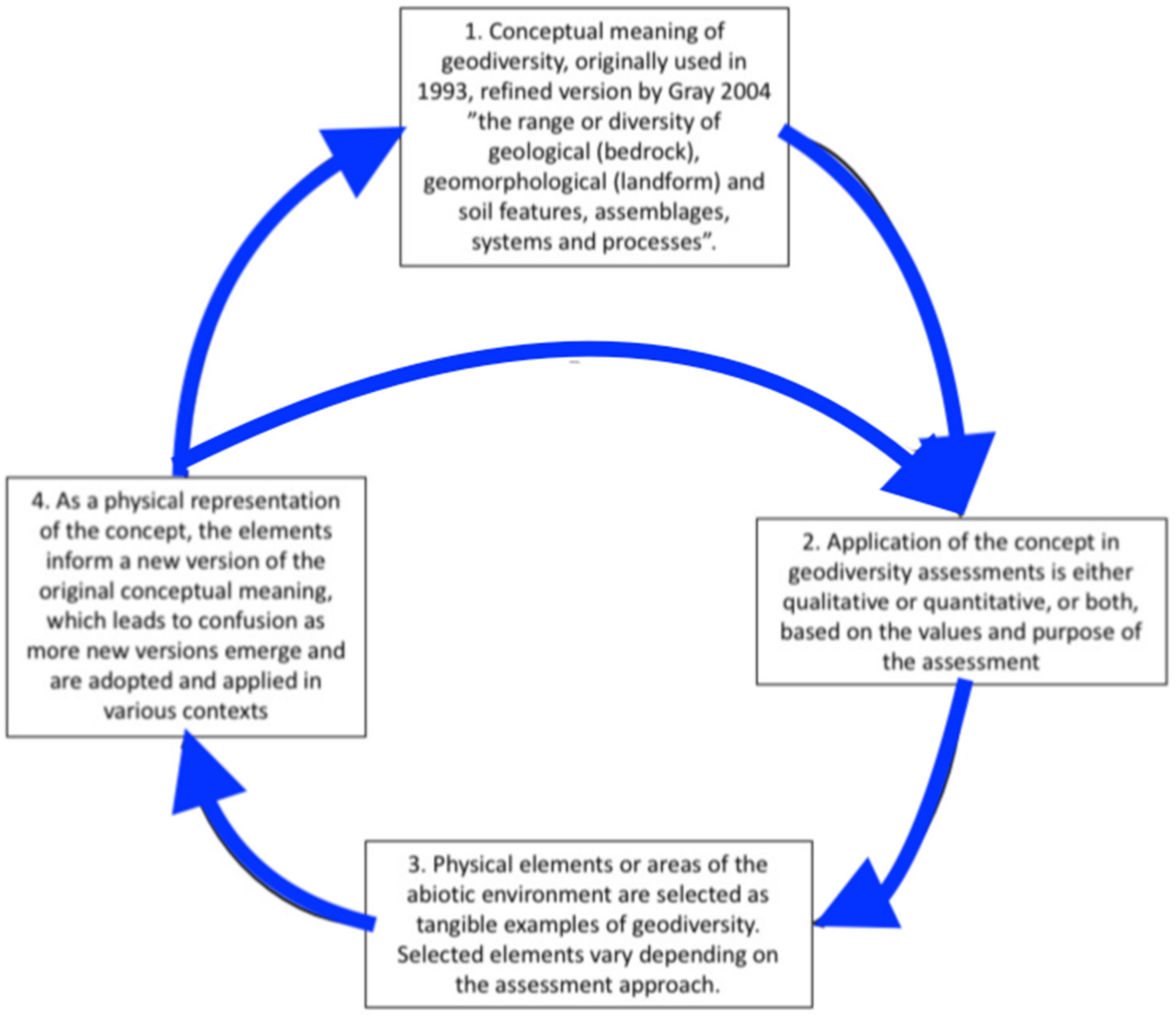
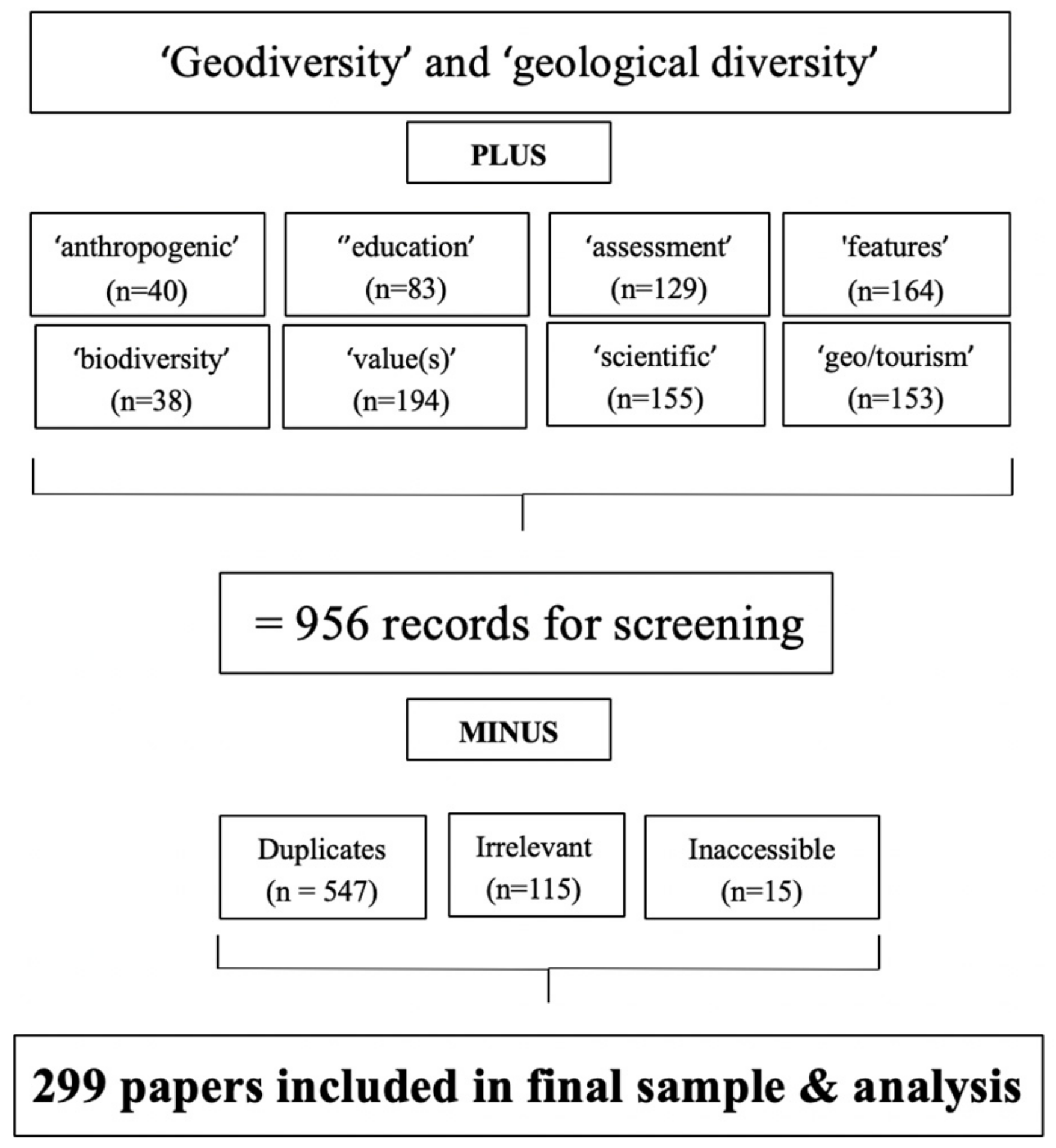
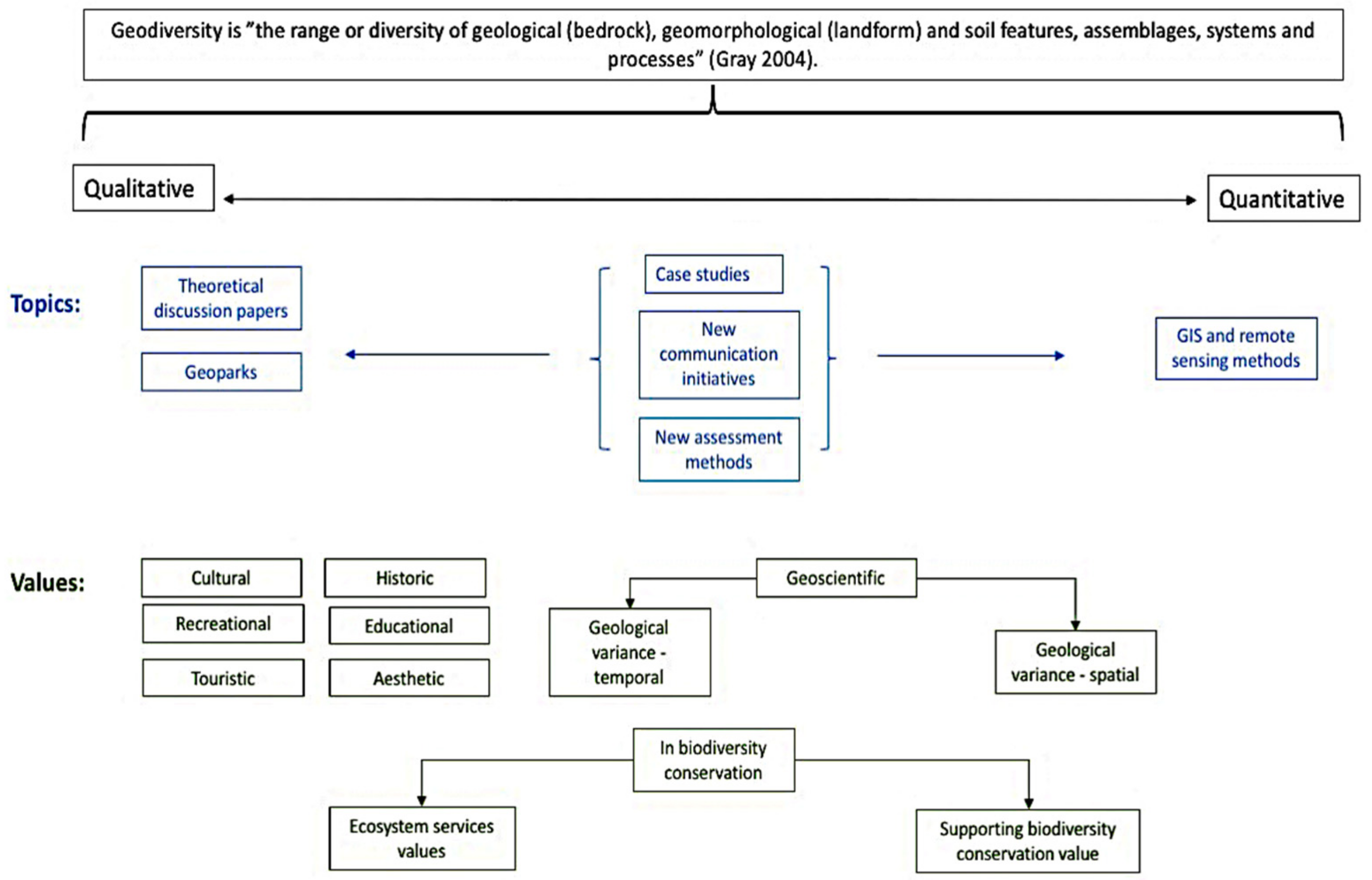
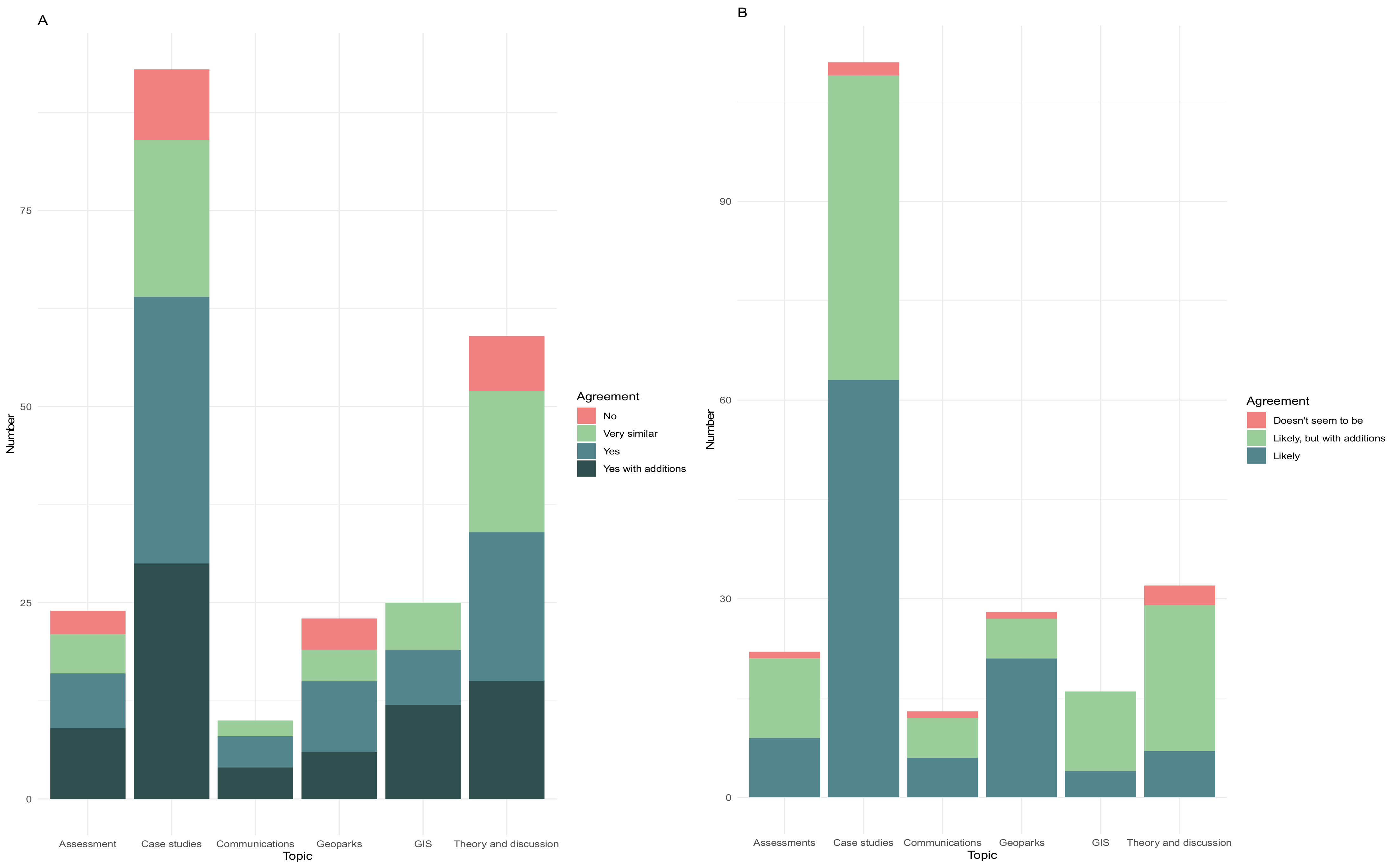
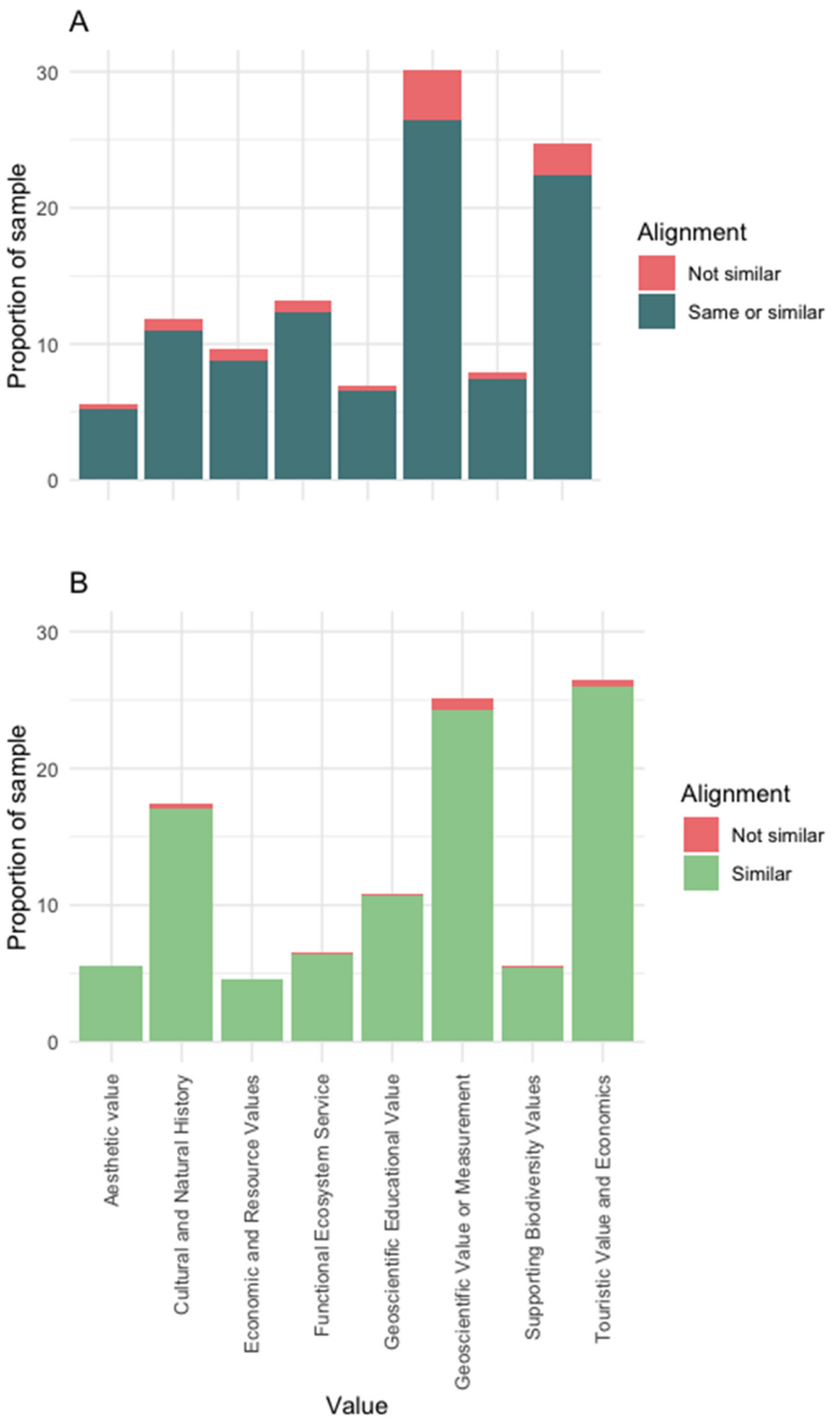
| The Explicit Definition (of Geodiversity) Provided In-Text Was That of [1] (or [14]): | The Definition (of Geodiversity) Inferred from Text: |
|---|---|
| Yes: 41% | |
| Yes, with some additions: 27% | Seemed like that of [1] (or [14]): 36% |
| Similar: 20% | was seemingly like [1] (or [14]), but with additions: 42% |
| No: 12% | Was seemingly not like [1] (or [14]): 22% |
| Focus of Paper | Description of Classification | Explicit (n) 1 | Inferred (n) 1 |
|---|---|---|---|
| Case Studies | Research on specific abiotic, geological, or landform elements and physical environments, typically so as to highlight their geoscientific, geoheritage, or ecological significance. | 93 | 111 |
| GIS and Remote Sensing | Research documenting or employing GIS or remote sensing techniques to ‘quantify’ or ‘assess’ geodiversity. | 25 | 16 |
| Geopark Studies | Primary or secondary research relating to national or UNESCO geoparks. | 23 | 28 |
| New Assessment Frameworks | New methods of assessing or determining geoheritage, landform significance, or geodiversity. | 24 | 22 |
| New Communication Initiatives | Authors and practitioners devised new inventory or instrument solutions to communicate and explore landforms, geographic elements, and/or geodiversity. | 10 | 13 |
| Theory and Discussion | The concept of geodiversity was explored or re-conceptualized as part of a major work (primarily qualitative). | 59 | 32 |
© 2019 by the authors. Licensee MDPI, Basel, Switzerland. This article is an open access article distributed under the terms and conditions of the Creative Commons Attribution (CC BY) license (http://creativecommons.org/licenses/by/4.0/).
Share and Cite
Boothroyd, A.; McHenry, M. Old Processes, New Movements: The Inclusion of Geodiversity in Biological and Ecological Discourse. Diversity 2019, 11, 216. https://doi.org/10.3390/d11110216
Boothroyd A, McHenry M. Old Processes, New Movements: The Inclusion of Geodiversity in Biological and Ecological Discourse. Diversity. 2019; 11(11):216. https://doi.org/10.3390/d11110216
Chicago/Turabian StyleBoothroyd, Anne, and Melinda McHenry. 2019. "Old Processes, New Movements: The Inclusion of Geodiversity in Biological and Ecological Discourse" Diversity 11, no. 11: 216. https://doi.org/10.3390/d11110216
APA StyleBoothroyd, A., & McHenry, M. (2019). Old Processes, New Movements: The Inclusion of Geodiversity in Biological and Ecological Discourse. Diversity, 11(11), 216. https://doi.org/10.3390/d11110216






